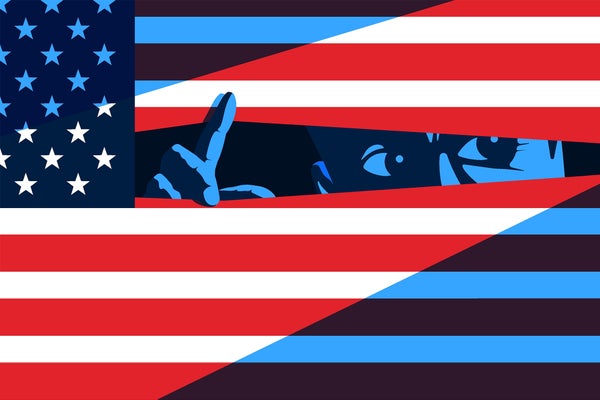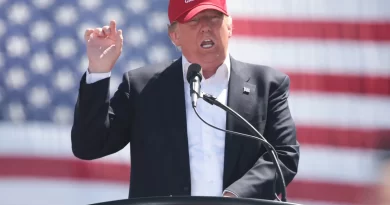State Secrecy Explains the Origins of the ‘Deep State’ Conspiracy Theory
February 6, 2024
5 min read
Lost in today’s misinformation fights is the recognition that modern conspiracy theories spring from excesses of state secrecy

From election denial to QAnon, the origins of our age of misinformation too often go unexamined. That’s too bad, because unraveling the roots of one popular conspiracy theory—of a “deep state”—might reveal something important about the cynicism now infecting U.S politics.
In the U.S., the idea of a deep state cabal of unelected officials secretively pulling the strings of American government, is widely believed. One 2018 poll even claimed that a majority of American voters place credence in the theory. This is no fringe phenomenon. America’s democratic political institutions and public opinion are riven by anxieties that have been given voice in the pronouncements of Donald Trump: “Either the deep state destroys America or we destroy the deep state,” he told a rally in Waco, Texas, in March 2023. This was nothing new. As president he frequently deployed the term, often to denounce whistleblowers and leakers from the U.S. intelligence community. Many of the January 6 Capitol rioters were inspired by QAnon conspiracy theories that claimed a deep state was working to undermine President Trump and betray the electorate. If he wins this November, Trump has promised to “dismantle the deep state” by stripping thousands of federal employees of their civil service protections, allowing them to be fired at will.
The intricate apophenia of today’s QAnon-laced cynicism toward the federal government as deep state finds its origins in legitimate public concern about cold war CIA covert operations. Knowing this history offers some answers for today’s conspiracy culture questions.
On supporting science journalism
If you’re enjoying this article, consider supporting our award-winning journalism by subscribing. By purchasing a subscription you are helping to ensure the future of impactful stories about the discoveries and ideas shaping our world today.
Before the CIA’s disastrous Bay of Pigs invasion of Cuba in 1961, the American media consciously avoided discussing U.S. covert action: “[W]e left out a great deal of what we knew about U.S. intervention in Guatemala and in a variety of other cases,” noted the New York Times’ Washington bureau chief, James Reston, in 1954. As a result, many of the CIA’s most significant operations escaped popular accountability.
In learning about these covert interventions in the 1960s and 1970s, the public became acutely aware of the gap between the official narrative of a purely defensive foreign policy and the reality of these previously secret offensive operations. That awareness caused many to ask who oversaw American foreign policy. Was it their elected public representatives or secretive intelligence officers?
One of the most influential books of this era to raise this question was The Invisible Government, written in 1964 by journalists David Wise and Thomas Ross. They opened their account with a stark declaration: “There are two governments in the United States today. One is visible. The other is invisible.” They then set out their thesis that the CIA had occasionally acted outside the authority of elected officials, and that such covert operations were not merely an instrument of U.S. foreign policy, but had actively shaped it. Though their thesis was more nuanced and narrowly focused than that of many contemporary purveyors of deep state conspiracy theories, their book provided the language and narrative apparatus that would eventually metastasize into the widespread skepticism in American society toward officialdom, and in particular toward the U.S. intelligence community.
The very use of the term conspiracy theory, however, risks both unfairly mischaracterizing Wise and Ross’s original argument, and trivializing the powerful hold that the “deep state” has upon the American political imagination today. Early attempts to understand what historian Richard Hofstadter famously described as the “paranoid style” in American political life deployed the term pejoratively. They pathologized political paranoia as an irrational and dangerous aberration from the usual politics of compromise and consensus that they believed characterized America’s democratic institutions.
But today the paranoid style has gone mainstream, and it has infiltrated the very organs of democratic politics that Hofstadter sought to defend. So how did public concern about CIA covert operations mutate into the all-encompassing cynicism toward government officials that characterizes belief in a deep state today? The Invisible Government was published at the beginning of an era of revelations about secret state activity and government deception. In 1967 Ramparts magazine revealed that the CIA had covertly sponsored the National Student Association to try to influence the emerging international student movement in a liberal and anticommunist direction. In 1971 Daniel Ellsberg provided the press with a secret Pentagon history of the Vietnam War, which revealed that four successive administrations had deceived the American people about the U.S. role in that conflict and the likelihood of victory. In December 1974, just a few months after President Nixon resigned over Watergate, itself a scandal about government secrecy and duplicity, New York Times journalist Seymour Hersh published the first of a series of articles about some of the most controversial CIA operations, leading to three separate official inquiries into the activities of the CIA and FBI.
Filtered through this steady drumbeat of revelations, The Invisible Government took on new meaning, with many coming to believe that the secret state was eroding the very foundations of American democracy. A 1967 Herblock cartoon about the scandal revealed by Ramparts magazine features Alice in Wonderland’s White Rabbit with “CIA” tattooed on its thigh, burrowing in a hole beneath the twin pillars of “U.S. Credibility” and “Integrity of Schools and Foundations,” with Alice tumbling down the rabbit hole of “undercover activities.”
These revelations of state secrecy and deception coupled with the narrative of an “invisible government” also lent credence to conspiracy theories about President Kennedy’s death, in particular the popular idea that the CIA played a role. The Invisible Government was here directly influential. In the late 1960s New Orleans district attorney Jim Garrison prosecuted Clay Shaw for Kennedy’s murder, alleging CIA involvement. Garrison drew at length from The Invisible Government when researching his prosecution. His case was flimsy, and the jury took less than an hour to deliver a “not guilty” verdict. But the trial was later popularized by Hollywood director Oliver Stone in his 1991 blockbuster JFK. In the film’s denouement a teary-eyed Garrison, played by Kevin Costner, delivers his closing argument to the jury: “What ‘national security,’” he asks them, “permits the removal of fundamental power from the hands of the American people and validates the ascendancy of the invisible government in the United States?” (Emphasis added.) The film was incredibly damaging for the CIA and helped persuade the agency to become much more proactive in its public relations.
Today the deployment of the “deep state” by populist politicians like Trump taps into a rich vein of popular suspicion in American society that partly resulted from excessive state secrecy and official deception. Since Hofstadter, we have tended to understand belief in conspiracy theories as a kind of psychosis. In doing so we have focused our gaze pejoratively on the “basket of deplorables” who tend to believe such theories, and ignored the official sources and government policies that first produced these widespread anxieties.
This is an opinion and analysis article, and the views expressed by the author or authors are not necessarily those of Scientific American.
This article has been archived for your research. The original version from Scientific American can be found here.


